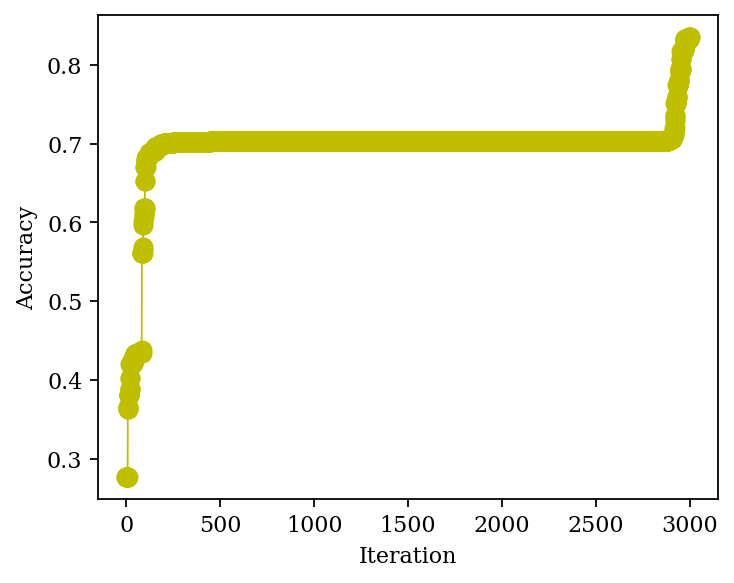python实现高效的遗传算法
遗传算法属于一种优化算法。
如果你有一个待优化函数,可以考虑次算法。假设你有一个变量x,通过某个函数可以求出对应的y,那么你通过预设的x可求出y_pred,y_pred差距与你需要的y当然越接近越好,这就需要引入适应度(fitness)的概念。假设
fitness = 1/(1+ads(y_pred - y)),那么误差越小,适应度越大,即该个体越易于存活。
设计该算法的思路如下:
(1)初始化种群,即在我需要的区间如[-100,100]内random一堆初始个体[x1,x2,x3...],这些个体是10进制形式的,为了后面的交叉与变异我们不妨将其转化为二进制形式。那么现在的问题是二进制取多少位合适呢?即编码(code)的长度是多少呢?
这就涉及一些信号方面的知识,比如两位的二进制表示的最大值是3(11),可以将区间化为4分,那么每一份区间range长度range/4,我们只需要让range/n小于我们定义的精度即可。n是二进制需要表示的最大,可以反解出二进制位数 。
(2)我们需要编写编码与解码函数。即code:将x1,x2...化为二进制,decode:在交叉变异后重新得到十进制数,用于计算fitness。
(3)交叉后变异函数编写都很简单,random一个point,指定两个x在point位置进行切片交换即是交叉。变异也是random一个point,让其值0变为1,1变为0。
(4)得到交叉变异后的个体,需要计算fitness进行种群淘汰,保留fitness最高的一部分种群。
(5)将最优的个体继续上面的操作,直到你定义的iteration结束为止。
不说了,上代码:
import numpy as np
import pandas as pd
import random
from scipy.optimize import fsolve
import matplotlib.pyplot as plt
import heapq
from sklearn.model_selection import train_test_split
from tkinter import _flatten
from sklearn.utils import shuffle
from sklearn import preprocessing
from sklearn.decomposition import PCA
from matplotlib import rcParams
# 求染色体长度
def getEncodeLength(decisionvariables, delta):
# 将每个变量的编码长度放入数组
lengths = []
for decisionvar in decisionvariables:
uper = decisionvar[1]
low = decisionvar[0]
# res()返回一个数组
res = fsolve(lambda x: ((uper - low) / delta - 2 ** x + 1), 30)
# ceil()向上取整
length = int(np.ceil(res[0]))
lengths.append(length)
# print("染色体长度:", lengths)
return lengths
# 随机生成初始化种群
def getinitialPopulation(length, populationSize):
chromsomes = np.zeros((populationSize, length), dtype=np.int)
for popusize in range(populationSize):
# np.random.randit()产生[0,2)之间的随机整数,第三个参数表示随机数的数量
chromsomes[popusize, :] = np.random.randint(0, 2, length)
return chromsomes
# 染色体解码得到表现形的解
def getDecode(population, encodelength, decisionvariables, delta):
# 得到population中有几个元素
populationsize = population.shape[0]
length = len(encodelength)
decodeVariables = np.zeros((populationsize, length), dtype=np.float)
# 将染色体拆分添加到解码数组decodeVariables中
for i, populationchild in enumerate(population):
# 设置起始点
start = 0
for j, lengthchild in enumerate(encodelength):
power = lengthchild - 1
decimal = 0
start_end = start + lengthchild
for k in range(start, start_end):
# 二进制转为十进制
decimal += populationchild[k] * (2 ** power)
power = power - 1
# 从下一个染色体开始
start = start_end
lower = decisionvariables[j][0]
uper = decisionvariables[j][1]
# 转换为表现形
decodevalue = lower + decimal * (uper - lower) / (2 ** lengthchild - 1)
# 将解添加到数组中
decodeVariables[i][j] = decodevalue
return decodeVariables
# 选择新的种群
def selectNewPopulation(decodepopu, cum_probability):
# 获取种群的规模和
m, n = decodepopu.shape
# 初始化新种群
newPopulation = np.zeros((m, n))
for i in range(m):
# 产生一个0到1之间的随机数
randomnum = np.random.random()
# 轮盘赌选择
for j in range(m):
if (randomnum < cum_probability[j]):
newPopulation[i] = decodepopu[j]
break
return newPopulation
# 新种群交叉
def crossNewPopulation(newpopu, prob):
m, n = newpopu.shape
# uint8将数值转换为无符号整型
numbers = np.uint8(m * prob)
# 如果选择的交叉数量为奇数,则数量加1
if numbers % 2 != 0:
numbers = numbers + 1
# 初始化新的交叉种群
updatepopulation = np.zeros((m, n), dtype=np.uint8)
# 随机生成需要交叉的染色体的索引号
index = random.sample(range(m), numbers)
# 不需要交叉的染色体直接复制到新的种群中
for i in range(m):
if not index.__contains__(i):
updatepopulation[i] = newpopu[i]
# 交叉操作
j = 0
while j < numbers:
# 随机生成一个交叉点,np.random.randint()返回的是一个列表
crosspoint = np.random.randint(0, n, 1)
crossPoint = crosspoint[0]
# a = index[j]
# b = index[j+1]
updatepopulation[index[j]][0:crossPoint] = newpopu[index[j]][0:crossPoint]
updatepopulation[index[j]][crossPoint:] = newpopu[index[j + 1]][crossPoint:]
updatepopulation[index[j + 1]][0:crossPoint] = newpopu[j + 1][0:crossPoint]
updatepopulation[index[j + 1]][crossPoint:] = newpopu[index[j]][crossPoint:]
j = j + 2
return updatepopulation
# 变异操作
def mutation(crosspopulation, mutaprob):
# 初始化变异种群
mutationpopu = np.copy(crosspopulation)
m, n = crosspopulation.shape
# 计算需要变异的基因数量
mutationnums = np.uint8(m * n * mutaprob)
# 随机生成变异基因的位置
mutationindex = random.sample(range(m * n), mutationnums)
# 变异操作
for geneindex in mutationindex:
# np.floor()向下取整返回的是float型
row = np.uint8(np.floor(geneindex / n))
colume = geneindex % n
if mutationpopu[row][colume] == 0:
mutationpopu[row][colume] = 1
else:
mutationpopu[row][colume] = 0
return mutationpopu
# 找到重新生成的种群中适应度值最大的染色体生成新种群
def findMaxPopulation(population, maxevaluation, maxSize):
#将数组转换为列表
#maxevalue = maxevaluation.flatten()
maxevaluelist = maxevaluation
# 找到前100个适应度最大的染色体的索引
maxIndex = map(maxevaluelist.index, heapq.nlargest(maxSize, maxevaluelist))
index = list(maxIndex)
colume = population.shape[1]
# 根据索引生成新的种群
maxPopulation = np.zeros((maxSize, colume))
i = 0
for ind in index:
maxPopulation[i] = population[ind]
i = i + 1
return maxPopulation
# 得到每个个体的适应度值及累计概率
def getFitnessValue(decode,x_train,y_train):
# 得到种群的规模和决策变量的个数
popusize, decisionvar = decode.shape
fitnessValue = []
for j in range(len(decode)):
W1 = decode[j][0:20].reshape(4,5)
V1 = decode[j][20:25].T
W2 = decode[j][25:45].reshape(5,4)
V2 = decode[j][45:].T
error_all = []
for i in range(len(x_train)):
#get values of hidde layer
X2 = sigmoid(x_train[i].T.dot(W1)+V1)
#get values of prediction y
Y_hat = sigmoid(X2.T.dot(W2)+V2)
#get error when input dimension is i
error = sum(abs(Y_hat - y_train[i]))
error_all.append(error)
#get fitness when W and V is j
fitnessValue.append(1/(1+sum(error_all)))
# 得到每个个体被选择的概率
probability = fitnessValue / np.sum(fitnessValue)
# 得到每个染色体被选中的累积概率,用于轮盘赌算子使用
cum_probability = np.cumsum(probability)
return fitnessValue, cum_probability
def getFitnessValue_accuracy(decode,x_train,y_train):
# 得到种群的规模和决策变量的个数
popusize, decisionvar = decode.shape
fitnessValue = []
for j in range(len(decode)):
W1 = decode[j][0:20].reshape(4,5)
V1 = decode[j][20:25].T
W2 = decode[j][25:45].reshape(5,4)
V2 = decode[j][45:].T
accuracy = []
for i in range(len(x_train)):
#get values of hidde layer
X2 = sigmoid(x_train[i].T.dot(W1)+V1)
#get values of prediction y
Y_hat = sigmoid(X2.T.dot(W2)+V2)
#get error when input dimension is i
accuracy.append(sum(abs(np.round(Y_hat) - y_train[i])))
fitnessValue.append(sum([m == 0 for m in accuracy])/len(accuracy))
# 得到每个个体被选择的概率
probability = fitnessValue / np.sum(fitnessValue)
# 得到每个染色体被选中的累积概率,用于轮盘赌算子使用
cum_probability = np.cumsum(probability)
return fitnessValue, cum_probability
def getXY():
# 要打开的文件名
data_set = pd.read_csv('all-bp.csv', header=None)
# 取出“特征”和“标签”,并做了转置,将列转置为行
X_minMax1 = data_set.iloc[:, 0:12].values
# 前12列是特征
min_max_scaler = preprocessing.MinMaxScaler()
X_minMax = min_max_scaler.fit_transform(X_minMax1) # 0-1 range
transfer = PCA(n_components=0.9)
data1 = transfer.fit_transform(X_minMax)
#print('PCA processed shape:',data1.shape)
X = data1
Y = data_set.iloc[ : , 12:16].values # 后3列是标签
# 分训练和测试集
x_train, x_test, y_train, y_test = train_test_split(X, Y, test_size=0.3)
return x_train, x_test, y_train, y_test
def sigmoid(z):
return 1 / (1 + np.exp(-z))
上面的计算适应度函数需要自己更具实际情况调整。
optimalvalue = []
optimalvariables = []
# 两个决策变量的上下界,多维数组之间必须加逗号
decisionVariables = [[-100,100]]*49
# 精度
delta = 0.001
# 获取染色体长度
EncodeLength = getEncodeLength(decisionVariables, delta)
# 种群数量
initialPopuSize = 100
# 初始生成100个种群,20,5,20,4分别对用W1,V1,W2,V2
population = getinitialPopulation(sum(EncodeLength), initialPopuSize)
print("polpupation.shape:",population.shape)
# 最大进化代数
maxgeneration = 4000
# 交叉概率
prob = 0.8
# 变异概率
mutationprob = 0.5
# 新生成的种群数量
maxPopuSize = 30
x_train, x_test, y_train, y_test = getXY()
for generation in range(maxgeneration):
# 对种群解码得到表现形
print(generation)
decode = getDecode(population, EncodeLength, decisionVariables, delta)
#print('the shape of decode:',decode.shape
# 得到适应度值和累计概率值
evaluation, cum_proba = getFitnessValue_accuracy(decode,x_train,y_train)
# 选择新的种群
newpopulations = selectNewPopulation(population, cum_proba)
# 新种群交叉
crossPopulations = crossNewPopulation(newpopulations, prob)
# 变异操作
mutationpopulation = mutation(crossPopulations, mutationprob)
# 将父母和子女合并为新的种群
totalpopulation = np.vstack((population, mutationpopulation))
# 最终解码
final_decode = getDecode(totalpopulation, EncodeLength, decisionVariables, delta)
# 适应度评估
final_evaluation, final_cumprob = getFitnessValue_accuracy(final_decode,x_train,y_train)
#选出适应度最大的100个重新生成种群
population = findMaxPopulation(totalpopulation, final_evaluation, maxPopuSize)
# 找到本轮中适应度最大的值
optimalvalue.append(np.max(final_evaluation))
index = np.where(final_evaluation == max(final_evaluation))
optimalvariables.append(list(final_decode[index[0][0]]))
fig = plt.figure(dpi = 160,figsize=(5,4))
config = {
"font.family":"serif", #serif
"font.size": 10,
"mathtext.fontset":'stix',
}
rcParams.update(config)
plt.plot(np.arange(len(optimalvalue)), optimalvalue, color="y", lw=0.8, ls='-', marker='o', ms=8)
# 图例设置
plt.xlabel('Iteration')
plt.ylabel('Accuracy')
plt.show()

以上就是python实现高效的遗传算法的详细内容,更多关于python遗传算法的资料请关注猪先飞其它相关文章!
相关文章
- 这篇文章主要介绍了python-opencv-画外接矩形框的实例代码,代码简单易懂,对大家的学习或工作具有一定的参考借鉴价值,需要的朋友可以参考下...2021-09-04
Python astype(np.float)函数使用方法解析
这篇文章主要介绍了Python astype(np.float)函数使用方法解析,文中通过示例代码介绍的非常详细,对大家的学习或者工作具有一定的参考学习价值,需要的朋友可以参考下...2020-06-08- 2022虎年新年即将来临,小编为大家带来了一个利用Python编写的虎年烟花特效,堪称全网最绚烂,文中的示例代码简洁易懂,感兴趣的同学可以动手试一试...2022-02-14
- 在本篇文章里小编给大家分享的是一篇关于python中numpy.empty()函数实例讲解内容,对此有兴趣的朋友们可以学习下。...2021-02-06
python-for x in range的用法(注意要点、细节)
这篇文章主要介绍了python-for x in range的用法,具有很好的参考价值,希望对大家有所帮助。一起跟随小编过来看看吧...2021-05-10- 这篇文章主要介绍了Python 图片转数组,二进制互转操作,具有很好的参考价值,希望对大家有所帮助。一起跟随小编过来看看吧...2021-03-09
- 这篇文章主要介绍了Python中的imread()函数用法说明,具有很好的参考价值,希望对大家有所帮助。一起跟随小编过来看看吧...2021-03-16
- 这篇文章主要介绍了python如何实现b站直播自动发送弹幕,帮助大家更好的理解和学习使用python,感兴趣的朋友可以了解下...2021-02-20
python Matplotlib基础--如何添加文本和标注
这篇文章主要介绍了python Matplotlib基础--如何添加文本和标注,帮助大家更好的利用Matplotlib绘制图表,感兴趣的朋友可以了解下...2021-01-26- 这篇文章主要介绍了解决python 使用openpyxl读写大文件的坑,具有很好的参考价值,希望对大家有所帮助。一起跟随小编过来看看吧...2021-03-13
- 今天小编就为大家分享一篇python 计算方位角实例(根据两点的坐标计算),具有很好的参考价值,希望对大家有所帮助。一起跟随小编过来看看吧...2020-04-27
- 这篇文章主要为大家详细介绍了python实现双色球随机选号,文中示例代码介绍的非常详细,具有一定的参考价值,感兴趣的小伙伴们可以参考一下...2020-05-02
- 在本篇文章里小编给大家整理的是一篇关于python中使用np.delete()的实例方法,对此有兴趣的朋友们可以学习参考下。...2021-02-01
- 这篇文章主要介绍了使用Python的pencolor函数实现渐变色功能,本文通过实例代码给大家介绍的非常详细,对大家的学习或工作具有一定的参考借鉴价值,需要的朋友可以参考下...2021-03-09
Python getsizeof()和getsize()区分详解
这篇文章主要介绍了Python getsizeof()和getsize()区分详解,文中通过示例代码介绍的非常详细,对大家的学习或者工作具有一定的参考学习价值,需要的朋友们下面随着小编来一起学习学习吧...2020-11-20- 这篇文章主要介绍了python自动化办公操作PPT的实现,文中通过示例代码介绍的非常详细,对大家的学习或者工作具有一定的参考学习价值,需要的朋友们下面随着小编来一起学习学习吧...2021-02-05
- 这篇文章主要介绍了解决python 两个时间戳相减出现结果错误的问题,具有很好的参考价值,希望对大家有所帮助。一起跟随小编过来看看吧...2021-03-12
- 这篇文章主要为大家详细介绍了python实现学生通讯录管理系统,文中示例代码介绍的非常详细,具有一定的参考价值,感兴趣的小伙伴们可以参考一下...2021-02-25
- 这篇文章主要介绍了PyTorch一小时掌握之迁移学习篇,本文给大家介绍的非常详细,对大家的学习或工作具有一定的参考借鉴价值,需要的朋友可以参考下...2021-09-08
- 这篇文章主要介绍了Python绘制的爱心树与表白代码,本文通过实例代码给大家介绍的非常详细,对大家的学习或工作具有一定的参考借鉴价值,需要的朋友可以参考下...2021-04-06
